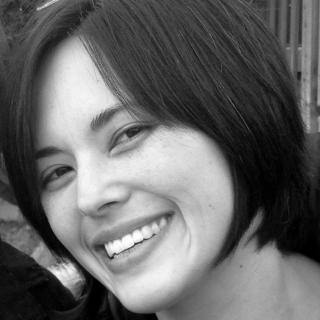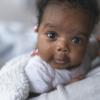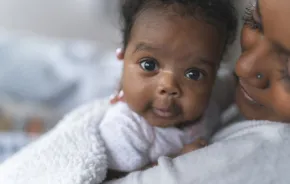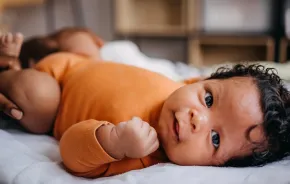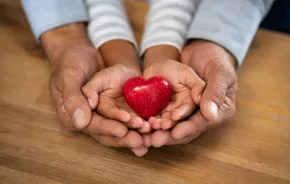When I walked into Under My Skin, the Wing Luke Museum’s exhibit on artists' exploration of race in the 21st century, the first thing I saw wasn’t art but big, bold letters: Race Still Matters. Next to this was a work by artist Jasmine Iona Brown: candles at an altar of murdered children as Byzantine icons. Brown was inspired to create this piece when she learned two African-American boys she had fostered were gunned down at 18 and 19 years old. I was crying within 15 minutes.
When I walked into RACE: Are We So Different?, a new exhibit at Seattle's Pacific Science Center, the first thing I saw was a wall-sized photo of diverse but disengaged public transit passengers. Most were not looking at the camera, except for a child in the aisle wearing a blank expression.
After walking through the glass doors of the exhibit, I was met by words again. This time, in medium font, was a panel with text from the American Anthropological Association: “Race is unscientific; are we really so different?” To say I felt a disconnect at that point would be a mild understatement.
Studies indicate that race is one of the most automatic ways people are categorized and that perceiving the race of others is more the norm than the exception. I know this firsthand as a multiracial woman often scrutinized for her ethnically ambiguous appearance. Our brains stubbornly persist on filing each other, and nothing highlights this need better (and emboldens others to say something about it) than a person who can’t be color-coded. My experience of race is of something interpersonal, sensitive and absolutely differentiating.
A framework for understanding
But at the Pacific Science Center exhibit, the panel text by the American Anthropological Association went on to note that despite the fact that race is unscientific, its legacy “continues to shape.” And this is speaking powerful truth.
RACE: Are We So Different? was developed by the American Anthropological Association in collaboration with the Science Museum of Minnesota. Their goal is not to provide answers so much as it is to foster dialogue and better relations. It is a national multimedia (web, video, audio, print) exhibit looking at race through three lenses: history, human variation and lived experience.
The exhibit opened January 2007 in St. Paul and has so far visited 37 U.S. cities. It is text-centric, but there are notable interactive pieces such as the opportunity to take a picture of your skin color, contribute to surveys, and learn about the human genome by touch screen.
Much of the in-depth research it presents is mind-blowing. For example, I learned from a panel on school resegregation that in many cities (including Seattle) schools have become as segregated as they were 50 years ago. When I spoke with Julie Nelson, Director of the Seattle Office for Civil Rights, she concurred.
“Seattle is a liberal place and there are a lot of progressive things we do to promote equality," Nelson said. "However, when it comes to racial inequities, we see the same racial inequities here as anywhere else in the country.”
Nelson feels the RACE exhibit offers an important opportunity to learn about the underlying policies and structures that maintain inequity, such as racial categorization in the U.S. Census, discrimination in ability-based tracking, the race gap in standardized text scores, as well as racism’s effects on health.

Nevertheless, throughout my visit I never did quite shake my first impression of personal disconnect from a very personal issue. I saw the exhibit. I learned from it. But I just didn’t feel it. In images, subjects are often smiling or completely unreadable. Artifacts feel far away behind glass. Data takes center stage at the same time RACE struggles to reconcile its driving science-based theme “Are we so different?” with a strong demonstration that we definitively are (via historical and statistical proof).
Though RACE weaves testimonials throughout and the human experience is one of its aims, engaging the emotional epicenter of racial discrimination is not its strength. And if we want to have catalyzing conversations around race with our children we need to not only learn fact – but understand hurt.

A heart and soul for healing
Feeling is fundamentally the core strength of Under My Skin: Artists Explore Race in the 21st Century at the Wing Luke Museum in Seattle, an exhibit that opened on May 10 and closes on November 17. Under My Skin features 26 artists from various ethnic backgrounds exploring race/racism from a range of perspectives including personal experience, rage and mourning, hope and healing. This is an art exhibit designed to be an intimate experience – full of vivid imagery, sounds, and stories – that builds emotional connection.
Take Fumi Matsumoto’s Ibara no Michi (pathway of thorns). By painfully weaving thorny rosebush branches to create a backdrop for teabag origami cranes, Matsumoto re-created the way Japanese incarcerated during World War II had to make art with whatever they could find in camp.

Or take artist Tatiana Garmendia (who was forced at 6 years old to watch the gang rape of an 8-year-old girl) and her piece Veils of Ignorance, which seeks to raise awareness about global violence against women.

We can't minimize the importance of history, research and science. But change cannot happen without compassion in addition to information. We spend so much time as parents trying to help our children learn empathy for good reason. When we understand the experiences of others, it helps us treat each other more kindly and opens the door to closer, more meaningful relationships.
The same is true of race and undoing racism. If we want our children to care and effect change, they need to connect. Which is why you just cannot visit RACE without visiting Under My Skin, too. One gives you the framework, the other gives you its heart and soul.
Age recommendations
First, a parental advisory: While there are painful realities on display at both exhibits, parents will find those pieces easier to navigate and filter at the Pacific Science Center. The Wing Luke, by contrast, has some heavy hitters that will easily capture the attention of children of kids over the age of 3 (especially an overhead audio on violence against women) and might result in tough questions. Don't be scared off, but do be prepared to have some important but uncomfortable conversations.
In general, RACE seems aimed largely at middle schoolers, but elementary-school-aged children will be able to process select information with help (e.g. examining skin colors and labels) and of course you yourself have much to gain. There are even a few pluses here for the littlest ones. The space is large with plenty of room to move. There’s a floor map they will love, plus a modest play area with different raced puppets and some anti-bias children’s books.
Under My Skin has toured groups ranging from fifth grade to the graduate level. There is much youth-friendly fodder here, including many colors, sights and sounds in the exhibit, plus interactive components such as taking your picture on a computer. That said, the physical arrangement and smaller space will prove challenging for those under age 5.
Support for school and youth groups
I do highly recommend parents ask older children’s teachers and group leaders to visit these exhibits. Both offer curriculum support with trained facilitators who will provide preparation and processing for groups. So much around race happens peer-to-peer outside the purview of our parenting, but not enough cross-cultural skills are facilitated in schools and learning environments. Diversity isn’t enough. Research shows children in diverse schools actually end up self-segregating, making transracial friendships less likely. Our kids need help understanding how to talk and relate to the members of their own cohort.
Groups interested in facilitation for Pacific Science Center’s Race should email Diana Falchuk at Diana.Falchuk@seattle.gov. The curriculum won’t be ready until later in October, but Falchuk recommends booking pre- and post-exhibit sessions now for visits beginning in November.
To schedule a workshop and guided tour of Under My Skin, contact the Wing Luke’s Tour Manager, Andrea Kim Taylor, at (206) 623-5124 ext.125 or ataylor@wingluke.org.
If you go …
RACE: Are We So Different? Admission to the exhibit is included with admission to the Pacific Science Center): $18 adults, $16 seniors (65+), $13 youth (6-15), $10 child (3-5), members free.
Under My Skin: Admission: $12.95 adults, $9.95 seniors (65+), $9.95 students (age 13-18 or with student ID), $8.95 youth (age 5-12), child (under age 5) and members free. First Thursday and third Saturday of the month admission free admission.
Resources
- RACE has a great website with helpful links and resources.
- Make sure you (re)read Parentmap’s December 2010 feature Are We Born Racist? The Talk You Must Have With Your Children.
- Follow my working Anti-Bias Children’s Booklist on Pinterest (currently 68 titles).
- Cracking the Codes: The System of Racial Inequity, a film by Shakti Butler
- Colorlines' team of investigative multiracial writers/reporters covering race issues from the perspective of community
- NPR’s Codeswitch: Frontiers of Race, Culture, and Ethnicity
- NurtureShock: New Thinking About Children by Po Bronson and Ashley Merryman
- Anti-Bias Education for Young Children and Ourselves by Louise-Derman Sparks and Julie Olsen Edwards
- Does Anybody Else Look Like Me?: A Parent’s Guide to Raising Multiracial Children by Donna Jackson Nakazawa
About the author: Sharon Chang lives in South Seattle, WA. She is among many things an early educator, graduate student in Human Development, researcher/writer, and blogger at Multiracial Asian Families and Racism Review. But most importantly she is “mommy,” “mom,” and sometimes “mama” to an exhausting and totally awesome 3-year-old.






